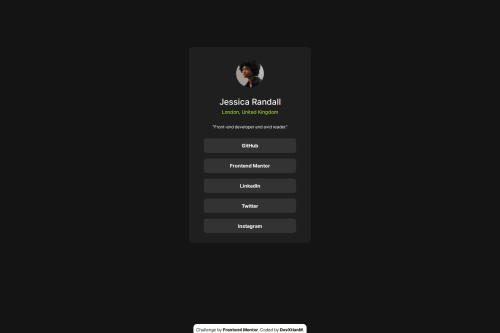Social Links Profile using HTML, CSS/SASS

Solution retrospective
I've developed the whole project with minimal searching for tutorial :D
Please log in to post a comment
Log in with GitHubCommunity feedback
- P@webdevbynight
Some feedback:
- the design file shows that the links texts are permanently bold, not only when hovered;
- you should enhance the semantics of your HTML: the attribution footer should be wraped by the
footerelement, the main content should be within themainelement and the card should be tagged as anarticleorsectionelement (don’t hesitate over having a look at the HTML elements reference on MDN); - you should use relative units for font sizes such as
emorrem: when using pixels to set font sizes, I am afraid this can lead to accessibility issues with users needing to be able to zoom texts in (by the way, you can define all dimensions, widths, paddings, margins, gaps… by using relative units: the design will get more elastic); - when possible, avoid using fixed heights: if you need to set a height, to use
min-heightis preferable; - if you want the whole container to occupy the whole height of the viewport, think of
min-height: 100 dvh(check for relative length units based on viewport if you do not know what such a unit stands for); - even if Sass is a great tool, you do not need to use Sass variables any more to define colour values, since CSS has custom properties;
- on
main.scss, line 41, just declarefont-weight: boldif you want to use the bold weight of the font (since there is only one font used, declared previously, you do not need to usefont-familyagain).
I hope this feedback helps you.
Marked as helpful
Join our Discord community
Join thousands of Frontend Mentor community members taking the challenges, sharing resources, helping each other, and chatting about all things front-end!
Join our Discord